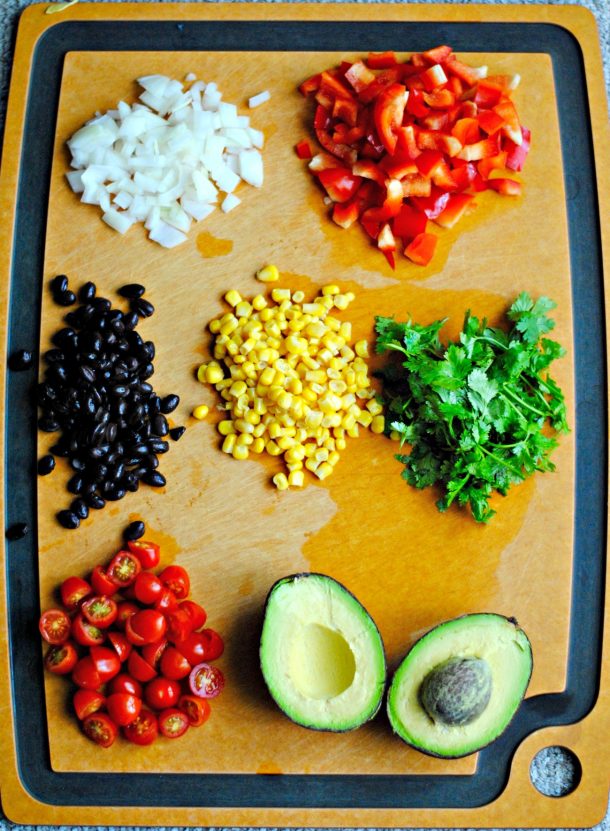I’ve had gastrointestinal issues for years, even dating back to my very youngest years. And this past year when I was spending time with a fellow blogger friend, she was telling me about the FODMAP diet, and suggested that it may be beneficial for me. But honestly, it sounded overwhelming and I already feel like I’m limited on food choices. I didn’t want to do it. Flash forward 2 months, and I’m back at the GI who suggests again that I try FODMAP. They sent me off with a one-page paper, and a bottle of iron to also take since I’m chronically low in ferritin. Two weeks later, I was at my wit’s end: I was fed up with all of my stomach issues and knew that I needed to make a change. I was ready to take on the FODMAP diet. And I want to share my experience with you.
My history with GI issues
Don’t worry – I won’t give you TMI here, but I do want you to understand that this has dated back to my youngest years. I was breastfed as a baby for only 3 weeks, after which I was given formula which didn’t sit well with me. Soy milk was the next best option, so that’s what I was given. Around the age of 7, I started having an issue eating citrus fruits, lettuce and more. I simply could not digest them, so I ended up avoiding them. I have memories of driving from Ohio to Florida and seeing all of the signs for oranges and orange juice as we neared the sunshine state. I remember how disappointed I was that I couldn’t have them. But the stomach issues that resulted were anything but worth it.
When I was in 4th grade, I realized that I again had an issue with lactose, so I had to go dairy-free. Lactose issues are common on my father’s side, so it wasn’t a big surprise. However, I again had to cut out more foods and was saddened by the inability to eat yogurt, and of course, ice cream. Oh, and who can forget pizza, an obvious child favorite.
The list goes on and on. I had an ulcer in college, digestive issues with certain fish, and last year I had to have an upper and lower endoscopy which showed that I have significant acid reflux. Really?? I honestly thought that some of this was just “the way that I am,” but I just couldn’t figure out why everyone else didn’t have the same issues.
I haven’t eaten red meat or pork in 24 years, I stopped eating all poultry 4 years ago, and instead now focus on a plant-based diet with the occasional fish and eggs. My point? I was eating a LOT of vegetables, lentils and beans. And suddenly I found myself experiencing problems daily – what a drag. I just couldn’t take it. Finally it was time for me to try the FODMAP diet.
What is the FODMAP diet?
Developed in 2005 by researchers at Monash University in Australia, FODMAP is an acronym for fermentable oligosaccharides, disaccharides, monosaccharide and polyols, types of carbohydrates that are difficult to digest and become fermented by bacteria, causing bloating and discomfort. By removing potential triggers to digestive distress and then reintroducing them a few weeks later, you’ll pinpoint your food intolerances and adjust your diet accordingly.
The list is not the easiest to follow – for example, you don’t just avoid all fruits but you can eat vegetables. Instead, you cut out some foods, such as onions, garlic and more than 1/8 of an avocado in a sitting. But then most greens are fine, as are all meats, poultry, fish and eggs. You cut out gluten and lactose but can include some gluten-free foods and a few hard cheeses or those with low lactose.
How I got started
I mentioned that the information that I found was overwhelming. And thus, even though I did adequate research myself, and even though I am a certified Holistic Health Coach, I sought out the help of a Registered Dietician. I wanted someone who had experience in working with the FODMAP diet to help me develop my own personal plan. The interesting thing about meeting her was seeing how our beliefs differed – for instance, she had empty bottles of low-fat milk on her shelves, vs. I always suggest organic whole milk and don’t condone low-fat foods. With that being said, she has been an amazing resource for me and has helped me learn A LOT about what foods to avoid and also what foods you can enjoy.
Some tips and hints about doing the FODMAP diet
- This is not meant to be something that is followed forever. Instead, it’s a way of eliminating foods that can be irritating your system. After 2-6 weeks (I did 3) of doing the elimination diet, you slowly add back in these foods to discover what foods are bothering you.
- I suggest talking with someone knowledgable on the topic, as mentioned above.
- Don’t cheat. It’s really not worth it, and it can undo all of the hard work that you have put in. If you want to get to the bottom of your stomach issues, I assure you that YOU CAN DO THIS!!
- Take time to plan your meals. There was a day when I didn’t have a plan, I was out of hard boiled eggs, didn’t have any gluten-free bread, and I was beyond frustrated, feeling like I had nothing to eat. Take the time to meal plan so that you’re not left staring at a refrigerator that holds no options for you.
- Download the Monash University Low FODMAP Diet App. This was a lifesaver for me. I’d be looking at a recipe, or standing in the grocery store and I would have no idea if a food was okay, or not okay. It breaks down foods and what types of servings are okay or not suggested on the diet.
Prepared foods that were helpful for me
While I have cooked and prepped A LOT, life definitely can get in the way. Some of my favorite packaged foods that I have been able to enjoy include the following:
GoMacro bars are made with simple, plant-based ingredients and are free of emulsifiers, artificial sugars, and preservatives. Since I can’t do peanut butter, I enjoyed Protein Purity (sunflower butter + chocolate), but Protein Pleasure and Protein Replenishment were suggested by my dietician.
Square Organic Protein Bars are vegan protein bars and are another great option. ** Note: coconut products are not fully tested and can cause symptoms in some.
Hemp Hearts Bites are yummy bite-sized snacks made with hemp hearts (great source of plant-based protein) and minimal ingredients.
Wild Caught Smoked Tuna pouches. I love these things; they come in salmon, too, which I would totally get if I could eat it, but my body just does not like salmon. Anyhow, they are great for mixing in with some cooked rice or for making a tuna salad for on-the-go.
Bread, which I made with Jovial Gluten Free Bread Flour (I used lactose-free milk in it). I also used this mix to make banana bread.
What I ate for 3 days of the 3 weeks that I did the FODMAP diet
| Breakfast | Snack | Lunch | Snack | Dinner | |
| Day 1 | Oatmeal with 3 large strawberries, 1 TBSP sun butter and almond milk. | Handful of walnuts and pecans | Kale & quinoa salad with few cherry tomatoes and 2 hardboiled eggs; 1 energy ball. | GoMacro bar | Super greens + 3 hard boiled eggs + cucumber + pepitas all topped with homemade green tahini sauce |
| Day 2 | 1 cup New Barn Almond Milk blended with 1/2 teaspoon turmeric, 1/2 teaspoon cinnamon and 15 pecans. | Banana (not ripe) | Romaine + quinoa salad with tuna and hemp hearts. Carrots on side. | 2 brown rice cakes with 1/8 avocado spread on top + pepitas; I spread 1.5 tsp of sunbutter on the other. | Brown rice, halibut baked with lemon juice, olive oil and salt, 1/2 sweet potato |
| Day 3 | Banana bread (from this book), but I altered the recipe slightly + an orange. | 1/2 cup black coffee + few gluten free pretzels | Lactose-free yogurt with rolled oats +1/2 a banana cut up mixed in. Cut peppers and tomatoes on side. | energy ball, 15 pecans, few GF pretzels | Tuna + avocado sushi roll made with brown rice/quinoa. 3 pieces of yellowtail nigiri + 3 pieces tuna sashimi. |
I made a bunch of recipes from this book, which I HIGHLY RECOMMEND. My 3rd daughter did the diet with me, too, and since she eats meat, I was able to make sure that she had adequate meals (that I also served my family). Every meal that I made from this book got two thumbs up. It’s also chock full of great information and serves as a very good resource.
Another great source of information is Kate Scarlata’s blog which has a wealth of good info. Oh, and I have some different recipes that are FODMAP friendly on my Pinterest page if you’d like to check them out (and maybe follow!)
Now the best news: I’m on my 3rd week of doing the FODMAP diet and I feel great!! And guess what? My 8 year-old daughter, who literally used to be able to pass gas on demand and whose stomach was always in pain is feeling fantastic. She even asked if we could do the diet for another week! But my follow-up appointment is on Thursday, after which we will start adding back foods in slowly to see what our triggers are.
I’m so happy that I tried the FODMAP diet and am anxious to find out my triggers. Look for a follow-up post next week, and please share your experience with this elimination diet too in the comments below.
This post may contain affiliate links which won’t change your price but will share some commission.









Hi Kiran – I’m currently on the low FODMAP diet per orders from my doctor. Thanks for these great resources! Even though I’m a personal chef and cooking instructor, I’m having trouble figuring out what to eat! So this post is a huge help.
Do you have any tips for adding things back in? Is there a certain order that you used? I haven’t been able to find much information about what to do after the time is up. Thanks!
Hi Sarah,
So glad that you have found this helpful! YES – first off, you should only follow this protocol for 2 – 6 weeks. I noticed a difference after just 3-4 days, but 2 weeks at a minimum will help your body to get to a point of being ready for reintroductions. I waited 6 weeks because I honestly felt so good!
I added back one item from each of the FODMAP groups per week. For example – Week 1 I added back in Galactans to see how my body would react. I started with 1/2 cup beans on day 1 and waited to see how I reacted. If you are okay, on day 3 you try a little bit more. Basically I tried day 1, nothing day 2 (in that category) and day 3 if I was okay on day 1, a little more. Wait day 4 and if still okay, try a bit more on day 5.
IMHO, it’s still somewhat difficult to pinpoint what bothers you. I did find out that onions and garlic are not great for me, but apples are a definite no-no. I already can’t do gluten or dairy, so those were easier to determine.
Feel free to comment again if I can further elaborate. So hopeful that this is helpful for you!
Kiran